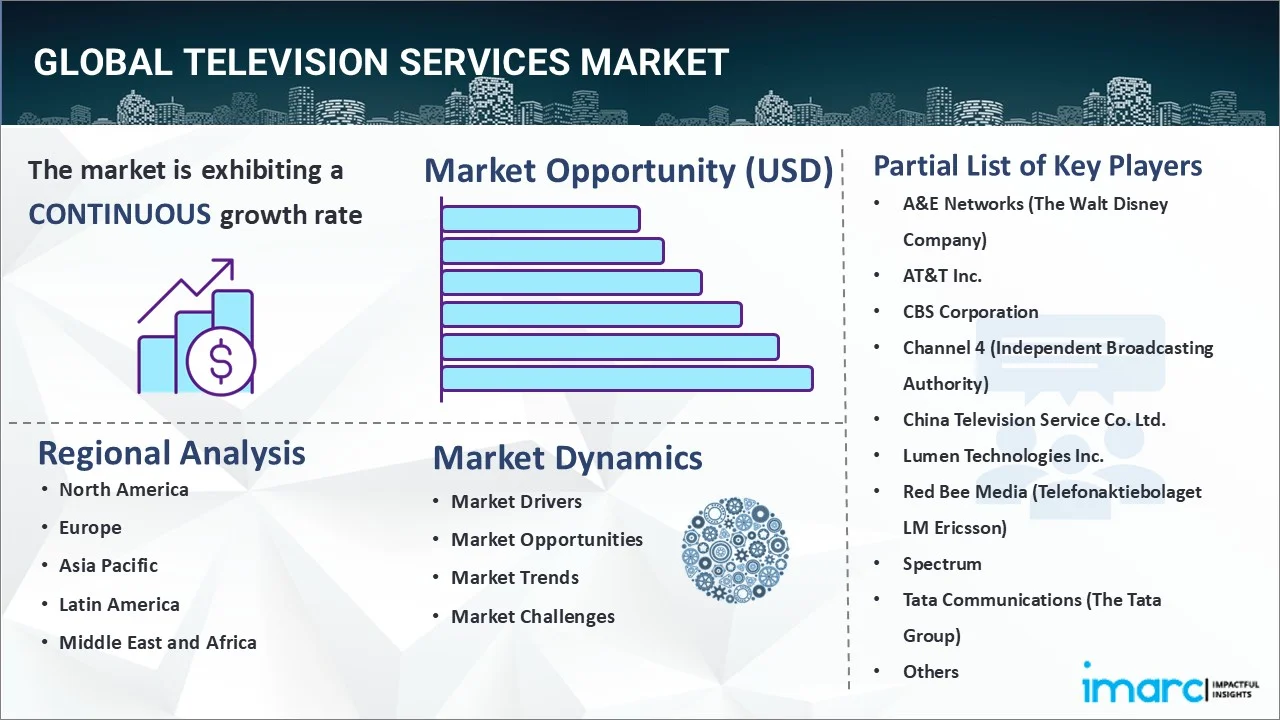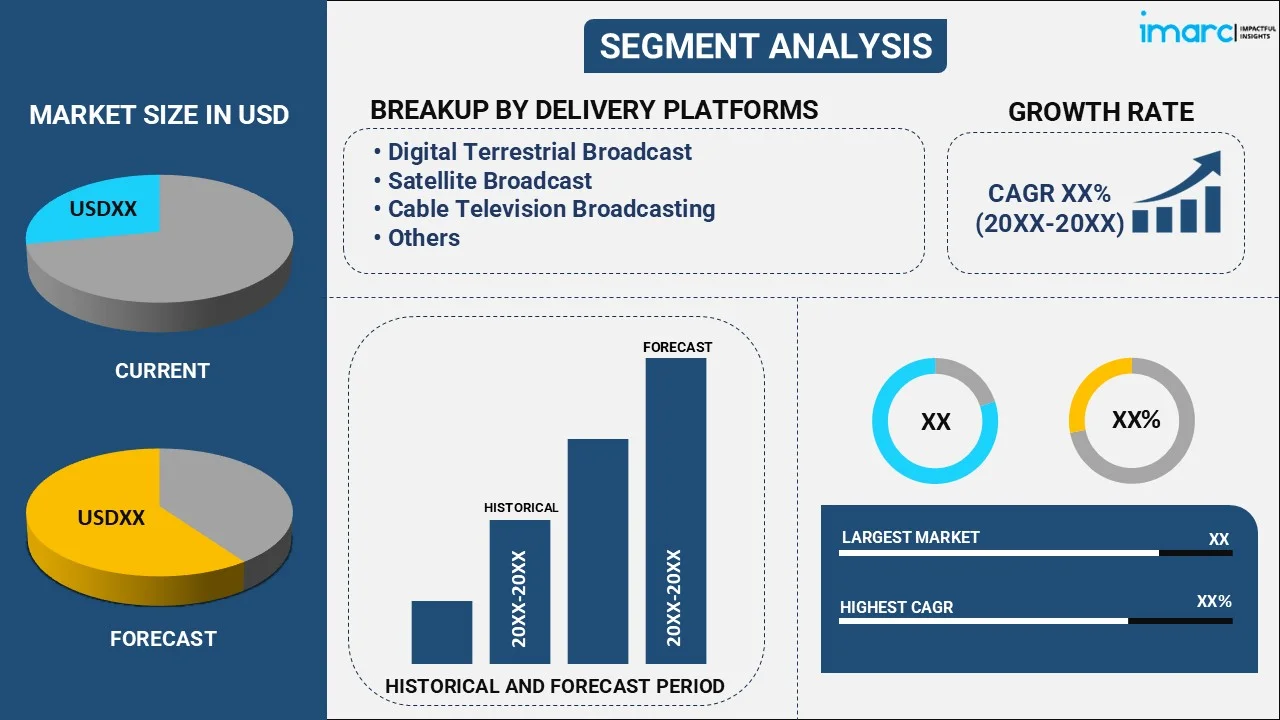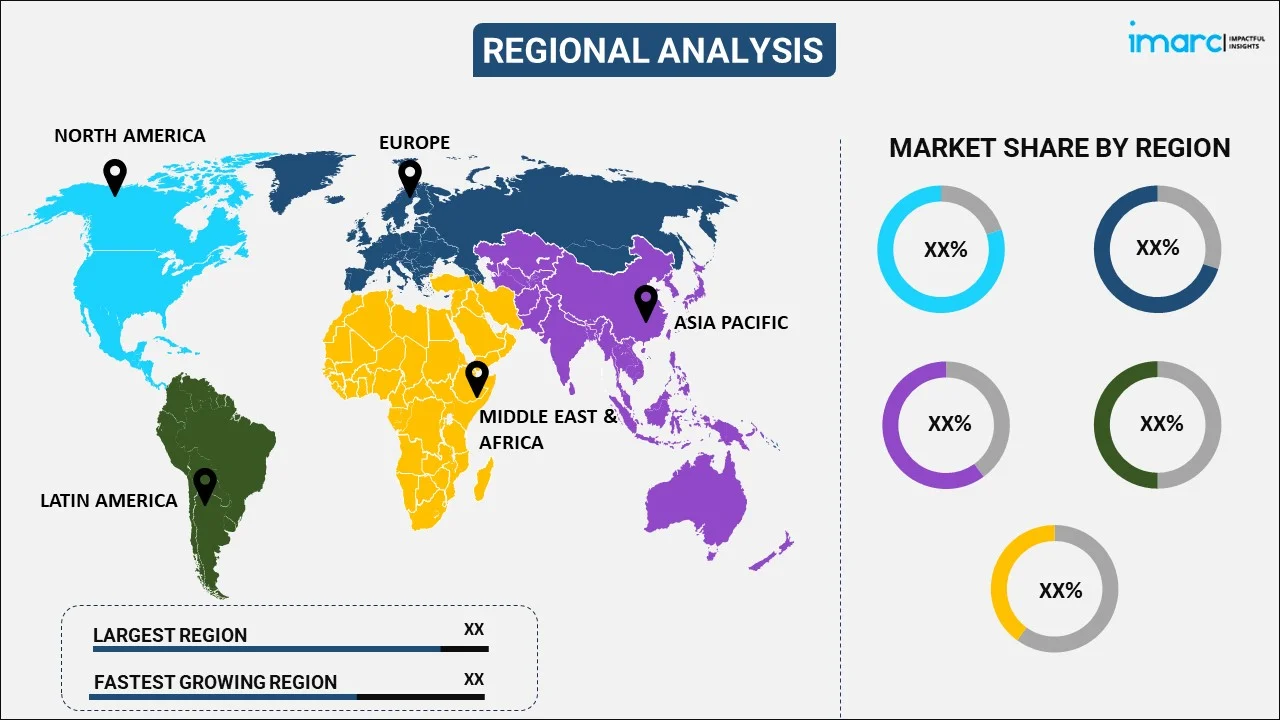
Television Services Market Report by Delivery Platform (Digital Terrestrial Broadcast, Satellite Broadcast, Cable Television Broadcasting, Internet Protocol Television (IPTV), Over-the-top Television (OTT)), Revenue Model (Subscription, Advertisement), Broadcaster Type (Public, Commercial), and Region 2025-2033
Global Television Services Market:
The global television services market size reached USD 373.5 Billion in 2024. Looking forward, IMARC Group expects the market to reach USD 555.0 Billion by 2033, exhibiting a growth rate (CAGR) of 4.28% during 2025-2033. The rising adoption of smart TVs worldwide is primarily driving the market growth.
|
Report Attribute
|
Key Statistics
|
|---|---|
|
Base Year
|
2024
|
|
Forecast Years
|
2025-2033
|
|
Historical Years
|
2019-2024
|
|
Market Size in 2024
|
USD 373.5 Billion |
|
Market Forecast in 2033
|
USD 555.0 Billion |
| Market Growth Rate 2025-2033 | 4.28% |
Television Services Market Analysis:
- Major Market Drivers: The worldwide expansion of internet infrastructure and the growing demand for high-definition content are providing a thrust to the market growth.
- Key Market Trends: The rise of ad-free subscription models and the adoption of cloud-based television services are acting as growth-inducing factors.
- Competitive Landscape: Some of the prominent television services market companies include A&E Networks (The Walt Disney Company), AT&T Inc., CBS Corporation, Channel 4 (Independent Broadcasting Authority), China Television Service Co. Ltd., Lumen Technologies Inc., Red Bee Media (Telefonaktiebolaget LM Ericsson), Spectrum, Tata Communications (The Tata Group), TiVo Corporation (Xperi Holding Corporation), Viacom18 Media Private Limited (TV18 Broadcast Limited), and Warner Bros. Discovery Inc., among many others.
- Geographical Trends: According to the television services market analysis report, North America dominates the market due to its advanced infrastructure and the widespread adoption of high-definition and streaming services. In addition, strong investment in original content and a mature consumer base with high disposable income are also fueling the demand for premium and diverse television experiences.
- Challenges and Opportunities: The increasing fragmentation of content across multiple platforms is hindering the market. However, offering bundled subscription options or universal search tools that streamline access to various services will continue to strengthen the market growth.

Television Services Market Trends:
Rise of Ad-Free Subscription Models
The growing consumer preference for uninterrupted viewing experiences is augmenting the market. These models generate revenue directly from subscriptions, allowing platforms to offer content without ads, enhancing viewer satisfaction, and driving the shift away from traditional ad-supported TV. For example, in June 2024, Netflix announced the launch of a free, ad-supported tier in select Asian and European markets. This move aims to expand its audience and compete with local free TV services while also boosting ad revenue through the development of an enhanced advertising technology platform by 2025.
Increase in mobile TV consumption
Mobile TV consumption is growing as viewers increasingly prefer watching television on smartphones and tablets. Enhanced mobile networks and affordable data plans have made it easier to stream content. This shift allows users to access content anywhere, henceforth boosting demand for mobile-optimized streaming services and content. For instance, in January 2024, BLAST introduced the beta version of its BLAST tv mobile app for iOS and Android. The app enhances the esports viewing experience by offering tailored features for fans, including live stats, 4K streaming, and interactive elements. This is expanding the television services market demand.
Collaborations between Telcom and Media Companies
Rising collaboration between telecom and media companies in television services enables bundled offerings, combining internet, TV, and streaming services. These partnerships enhance customer retention, expand market reach, and provide consumers with integrated solutions, driving growth and innovation in the television services market. For example, in March 2024, Tata Play and Disney Star launched the Tata Play 4K service, providing an ultra-high definition 4K TV viewing experience. This collaboration aims to revolutionize sports and entertainment viewing in India, thereby offering enhanced clarity and immersion for subscribers at an affordable price.
Global Television Services Industry Segmentation:
IMARC Group provides an analysis of the key trends in each segment of the global television services market forecast at the global, regional, and country levels from 2025-2033. Our report has categorized the market based on delivery platform, revenue model, and broadcaster type.
Breakup by Delivery Platform:

- Digital Terrestrial Broadcast
- Satellite Broadcast
- Cable Television Broadcasting
- Internet Protocol Television (IPTV)
- Over-the-top Television (OTT)
Cable television broadcasting dominates the market share
The report has provided a detailed breakup and analysis of the market based on the delivery platform. This includes digital terrestrial broadcast, satellite broadcast, cable television broadcasting, internet protocol television (IPTV), and over-the-top television (OTT). According to the report, cable television broadcasting represented the largest market segmentation.
Cable television broadcasting dominates the market due to its widespread infrastructure and large subscriber base. For example, in the U.S., companies like Comcast continue to lead with extensive cable networks, offering bundled services that attract and retain customers. This is elevating the television services market forecast report.
Breakup by Revenue Model:
- Subscription
- Advertisement
Subscription dominates the television services market share
The report has provided a detailed breakup and analysis of the market based on the revenue model. This includes subscription and advertisement. According to the report, subscription represented the largest market segmentation.
The subscription model dominates the segment, driven by the increasing preference for ad-free, on-demand content. For example, Netflix’s vast global subscriber base illustrates how consumers favor subscription services for accessing diverse, high-quality entertainment at their convenience.
Breakup by Broadcaster Type:
- Public
- Commercial
Commercial dominates the television services market
The report has provided a detailed breakup and analysis of the market based on the broadcaster type. This includes public and commercial. According to the report, commercial represented the largest market segmentation.
The commercial sector dominates the market, driven by significant advertising revenue and the demand for prime content slots. This dominance underscores the influence of commercial investments in shaping programming. This is driving the overall television services market outlook.
Breakup by Region:

- North America
- United States
- Canada
- Asia-Pacific
- China
- Japan
- India
- South Korea
- Australia
- Indonesia
- Others
- Europe
- Germany
- France
- United Kingdom
- Italy
- Spain
- Russia
- Others
- Latin America
- Brazil
- Mexico
- Others
- Middle East and Africa
North America dominates the market
The report has also provided a comprehensive analysis of all the major regional markets, which include North America (the United States and Canada); Asia Pacific (China, Japan, India, South Korea, Australia, Indonesia, and others); Europe (Germany, France, the United Kingdom, Italy, Spain, Russia and others); Latin America (Brazil, Mexico, and others); and the Middle East and Africa. According to the report, North America accounted for the largest market share.
According to the television services market outlook report, North America dominates the market due to its advanced technological infrastructure, widespread adoption of high-definition and streaming services, and a large affluent consumer base with high disposable incomes. The region's strong media and entertainment industry, coupled with significant investments in content creation and distribution, further strengthens its market leadership. In line with this, the presence of major players like Netflix, Disney, and Comcast, along with robust advertising revenue streams, will continue to fuel the regional market in the coming years.
Competitive Landscape:
The television services market research report has provided a comprehensive analysis of the competitive landscape. Detailed profiles of all major market companies have also been provided. Some of the key players in the market include:
- A&E Networks (The Walt Disney Company)
- AT&T Inc.
- CBS Corporation
- Channel 4 (Independent Broadcasting Authority)
- China Television Service Co. Ltd.
- Lumen Technologies Inc.
- Red Bee Media (Telefonaktiebolaget LM Ericsson)
- Spectrum
- Tata Communications (The Tata Group)
- TiVo Corporation (Xperi Holding Corporation)
- Viacom18 Media Private Limited (TV18 Broadcast Limited)
- Warner Bros. Discovery Inc.
(Please note that this is only a partial list of the key players, and the complete list is provided in the report.)
Television Services Market Recent Developments:
- June 2024: Netflix launched a free, ad-supported tier in select Asian and European markets to expand its audience and compete with local free television service providers.
- March 2024: Tata Play and Disney Star unveiled the Tata Play 4K service, providing an ultra-high definition 4K TV viewing experience and enhanced clarity for subscribers at an affordable price.
- January 2024: BLAST introduced the beta version of its BLAST tv mobile app for iOS and Android. The app enhances the esports viewing experience by offering tailored features for fans, including live stats, 4K streaming, and interactive elements.
Television Services Market Report Scope:
| Report Features | Details |
|---|---|
| Base Year of the Analysis | 2024 |
| Historical Period | 2019-2024 |
| Forecast Period | 2025-2033 |
| Units | Billion USD |
|
Scope of the Report |
Exploration of Historical Trends and Market Outlook, Industry Catalysts and Challenges, Segment-Wise Historical and Predictive Market Assessment:
|
| Delivery Platforms Covered | Digital Terrestrial Broadcast, Satellite Broadcast, Cable Television Broadcasting, Internet Protocol Television (IPTV), Over-the-top Television (OTT) |
| Revenue Models Covered | Subscription, Advertisement |
| Broadcaster Types Covered | Public, Commercial |
| Regions Covered | Asia Pacific, Europe, North America, Latin America, Middle East and Africa |
| Countries Covered | United States, Canada, Germany, France, United Kingdom, Italy, Spain, Russia, China, Japan, India, South Korea, Australia, Indonesia, Brazil, Mexico |
| Companies Covered | A&E Networks (The Walt Disney Company), AT&T Inc., CBS Corporation, Channel 4 (Independent Broadcasting Authority), China Television Service Co. Ltd., Lumen Technologies Inc., Red Bee Media (Telefonaktiebolaget LM Ericsson), Spectrum, Tata Communications (The Tata Group), TiVo Corporation (Xperi Holding Corporation), Viacom18 Media Private Limited (TV18 Broadcast Limited), Warner Bros. Discovery Inc., etc. |
| Customization Scope | 10% Free Customization |
| Post-Sale Analyst Support | 10-12 Weeks |
| Delivery Format | PDF and Excel through Email (We can also provide the editable version of the report in PPT/Word format on special request) |
Key Benefits for Stakeholders:
- IMARC's report offers a comprehensive quantitative analysis of various market segments, historical and current market trends, market forecasts, and dynamics of the television services market from 2019-2033.
- The research study provides the latest information on the market drivers, challenges, and opportunities in the global television services market.
- The study maps the leading, as well as the fastest-growing, regional markets. It further enables stakeholders to identify the key country-level markets within each region.
- Porter's five forces analysis assists stakeholders in assessing the impact of new entrants, competitive rivalry, supplier power, buyer power, and the threat of substitution. It helps stakeholders to analyze the level of competition within the television services industry and its attractiveness.
- The competitive landscape allows stakeholders to understand their competitive environment and provides insight into the current positions of key players in the market.
Key Questions Answered in This Report
The global television services market was valued at USD 373.5 Billion in 2024.
We expect the global television services market to exhibit a CAGR of 4.28% during 2025-2033.
The rising integration of the Internet of Things (IoT) to stream on-demand shows through other electronic devices, along with the widespread adoption of Augmented Reality (AR) and Virtual Reality (VR) technologies to attain an immersive experience while consuming digital content, is primarily driving the global television services market.
The sudden outbreak of the COVID-19 pandemic has led to the increasing demand for various television services, such as Over-The-Top (OTT) and subscription-based content for entertainment purposes among individuals during the lockdown scenario.
Based on the delivery platform, the global television services market can be bifurcated into digital terrestrial broadcast, satellite broadcast, cable television broadcasting, Internet Protocol Television (IPTV), and Over-the-top Television (OTT). Currently, cable television broadcasting holds the majority of the total market share.
Based on the revenue model, the global television services market has been segmented into subscription and advertisement, where subscription currently exhibits a clear dominance in the market.
Based on the broadcaster type, the global television services market can be divided into public and commercial. Currently, commercial accounts for the largest market share.
On a regional level, the market has been classified into North America, Asia-Pacific, Europe, Latin America, and Middle East and Africa, where North America currently dominates the global market.
Some of the major players in the global television services market include A&E Networks (The Walt Disney Company), AT&T Inc., CBS Corporation, Channel 4 (Independent Broadcasting Authority), China Television Service Co. Ltd., Lumen Technologies Inc., Red Bee Media (Telefonaktiebolaget LM Ericsson), Spectrum, Tata Communications (The Tata Group), TiVo Corporation (Xperi Holding Corporation), Viacom18 Media Private Limited (TV18 Broadcast Limited), and Warner Bros. Discovery Inc.
Need more help?
- Speak to our experienced analysts for insights on the current market scenarios.
- Include additional segments and countries to customize the report as per your requirement.
- Gain an unparalleled competitive advantage in your domain by understanding how to utilize the report and positively impacting your operations and revenue.
- For further assistance, please connect with our analysts.
 Inquire Before Buying
Inquire Before Buying
 Speak to an Analyst
Speak to an Analyst
 Request Brochure
Request Brochure
 Request Customization
Request Customization




.webp)




.webp)












